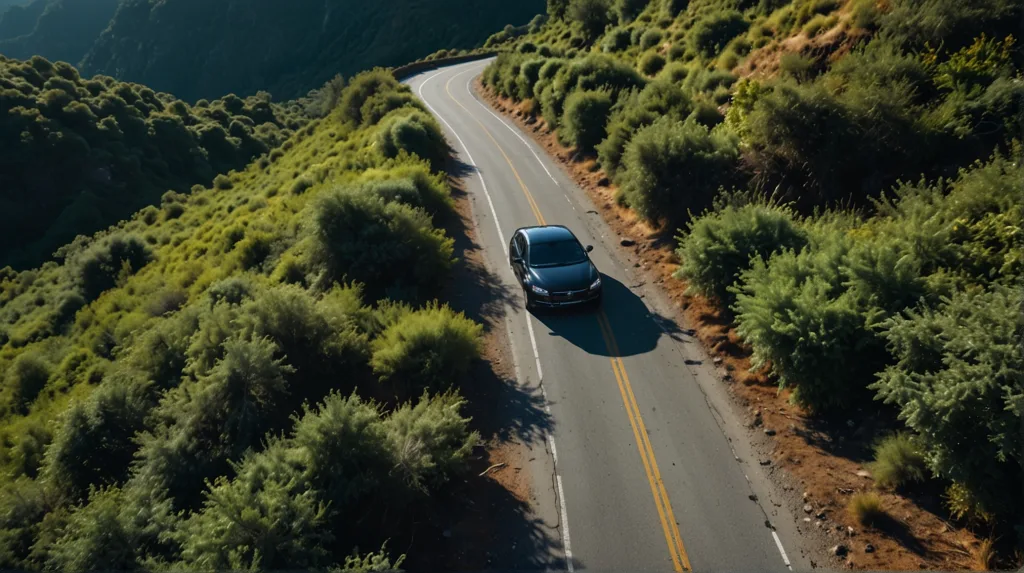If your vehicle runs off the road, remain calm and slowly reduce your speed. Steer gradually to return to the roadway, ensuring it’s safe to do so.
Encountering a situation where your vehicle veers off the pavement can be alarming. Quick thinking and composed actions significantly increase your chances of regaining control without harm. Your immediate response should focus on stabilizing the vehicle and preventing a more severe accident, such as a rollover or collision.
It’s crucial to understand that overreacting, particularly with abrupt steering or braking, often exacerbates the problem. Guidance on handling such events is widely available, usually including defensive driving techniques and how to react during vehicle skids. This knowledge can prove invaluable, especially when traversing challenging road conditions or dealing with unexpected roadside hazards. These introductions to safety practices can be lifesaving and are essential for all drivers to learn and recall.

Initial Response To Road Departure
Encountering a road departure can be a frightening experience.
The right initial response is crucial to ensure safety and minimize damage.
Regaining Control
Upon drifting off the pavement, stay calm and focus on your vehicle’s direction.
Here are steps to regain control:
- Keep a firm grip on the steering wheel.
- Avoid sudden steering maneuvers.
- Gently steer back toward the road, if safe.
Reducing Speed Safely
Managing your vehicle’s speed is crucial.
Do not slam on the brakes.
- Lift your foot off the accelerator.
- Apply brakes lightly, if necessary.
- Downshift to a lower gear to help slow down.

Assessing The Situation
After your vehicle veers off the road, taking the right steps ensures safety for everyone inside. Trust your instincts but also remember a few key guidelines. Remain calm, you’ve got this.
Vehicle And Occupant Safety
First, check for injuries. Are you hurt? What about passengers? If anyone is injured, call 911 immediately. Use your hazard lights to alert other drivers. They’re important for safety. Keep them on.
When To Exit The Vehicle
Exiting the car can be risky, especially on busy roads. Think before acting. Is your car stable? Is traffic nearby? Stay inside if it’s safer. Leave the vehicle only if you can avoid danger.
| Condition | Action |
|---|---|
| Smoke or fire | Exit immediately |
| Power lines down | Stay put, call for help |
| Stable vehicle, no immediate threat | Proceed with caution |
- Turn off the engine to avoid any potential for fire or further damage.
- Only move if it’s safe – assess your environment before taking action.
Reflective triangles or flares can provide additional warning to oncoming traffic. Place them strategically if you can safely do so.
Calling For Help
Stuck with a vehicle off the road? Your safety is the top priority. It’s crucial to call for help promptly. Knowing who to contact and how to share your location can make all the difference. Follow these steps to ensure rescuers reach you swiftly.
Who To Contact First
Immediately after an off-road incident, asses your safety. If you are in danger, dial 911. These situations qualify as emergencies. For non-life-threatening scenarios, call roadside assistance. Ensure your vehicle’s insurance provider is contacted next.
Roadside assistance numbers are often found on:
- Insurance cards
- Vehicle manuals
- Inside your glove compartment
Sharing Your Location
Accurate location details are crucial for timely help. Use your smartphone’s location services. Open a map application to find your coordinates. This data is life-saving during such events.
Send your location by:
- Accessing your map app
- Tap on your position
- Choose the option to share
- Send it to the help you’ve contacted
If technology fails, describe landmarks, road signs, or any unique features nearby.

Awaiting Assistance
If your vehicle suddenly swerves off the road, remain calm. Once you’ve ensured that you and any passengers are safe and you’ve called for help, the wait begins. But being sidelined on the fringe of the road demands more than just patience.
Staying Visible
Visibility is crucial for your safety while waiting for roadside assistance. Take these steps:
- Deploy your hazard lights as soon as you realize you’re off the road.
- Set up reflective triangles or flares to alert approaching drivers.
- Keep interior dome lights on at night if your battery isn’t at risk.
Preparing For Weather Conditions
Weather can change fast, so be ready:
| Condition | Tips |
|---|---|
| Heat | Stay hydrated, use a sunshade, and don’t leave pets in the car. |
| Rain | Keep windows slightly open and stay inside to avoid slippery surroundings. |
| Snow | Bundle up in warm clothing and keep an emergency blanket in the car. |
Remember to stock your vehicle with necessities for unexpected holds. A proper emergency kit with blankets, water, snacks, a flashlight, and a first-aid kit can make waiting safer and more comfortable.
Preventative Measures
Staying safe while driving means preparing before a problem occurs. Smart drivers take steps to prevent accidents. This part of our post explores ways to keep your vehicle on the road.
Regular Vehicle Maintenance
Keeping your car in top shape is vital. Well-maintained vehicles handle better. This helps to avoid running off the road. Schedule regular check-ups. Look at the points below for a safer ride:
- Check your brakes: Good brakes can stop accidents.
- Monitor tire pressure: Properly inflated tires grip the road better.
- Replace worn tires: New tires mean more traction.
- Test your lights: Bright lights help you see and be seen.
- Inspect steering and suspension systems: These help you control your car.
Defensive Driving Techniques
Defensive driving keeps you alert. It helps you react quickly to avoid danger. Follow these key techniques:
- Stay focused on the road: Distractions cause crashes.
- Keep a safe distance: More space gives you more time to react.
- Expect the unexpected: Always be ready for sudden changes.
- Slow down in bad weather: Rain, snow, and ice make roads slippery.
- Obey traffic signs: They guide you for safety.
Frequently Asked Questions Of What To Do If Your Vehicle Runs Off The Road
How Should You React If Your Car Runs Off The Pavement?
React calmly if your car leaves the pavement. Steadily slow down, don’t jerk the steering wheel. Once slowed, check for traffic, and gently steer back onto the road.
What Should You Do If Your Car Has Gone Partially Off The Road Onto The Dirt Shoulder?
Stay calm and keep your steering wheel straight. Slowly reduce your speed. Check traffic and, when safe, steer gradually onto the pavement. Don’t overcorrect or brake harshly. Resume driving when fully on the road.
What To Do If My Car Stops In The Middle Of The Road?
Turn on your hazard lights immediately. Gently guide your car to safety, off the roadway if possible. Use reflective triangles or flares for visibility. Contact roadside assistance or emergency services. Remain in your car if it’s unsafe outside.
What Should You Do If You Run Your Right Or Left Wheels Off The Road?
Immediately reduce your speed. Keep a firm grip on the steering wheel. Gradually steer back onto the road. Avoid overcorrecting. Stay calm and proceed with caution.
Conclusion
Dealing with a roadside vehicle emergency can be daunting. Remaining calm and following these steps ensures safety and quick assistance. Always keep an emergency kit in your car, and don’t forget to maintain your presence of mind. Safe driving practices can minimize such incidents, but always prepare for the unexpected.
Stay safe on the roads!


